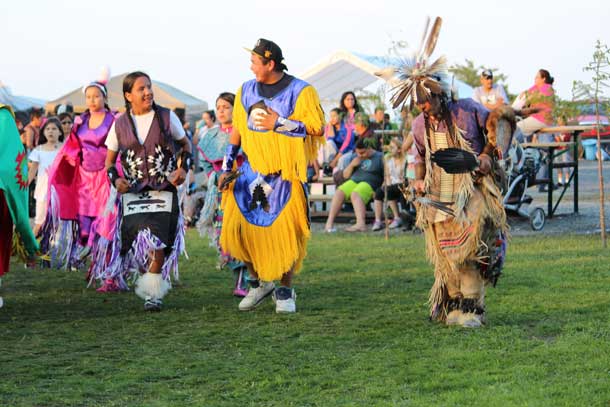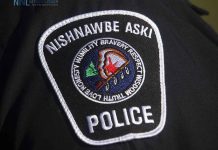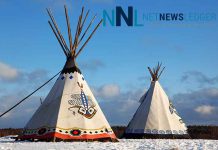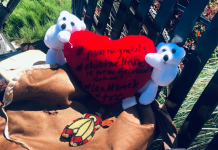Hope Takes the Next Plane Out?
If I were to make a PSA about the difference between mainstream schools and northern Aboriginal schools, I would start with a shot of a classroom in Ontario’s south. The walls are filled with pictures, posters, charts, blackboards, smart boards. The desks are pristine except for the tablets. The lights are bright. The teacher is talking animatedly and the students are rapt.
The picture morphs into another classroom. The walls have posters, charts and blackboards.There are pictures with words in syllabic. The windows are cracked, snow rages outside, and the desks are rusty and something like 30 years old. Some of the lights are burnt out. The kids are wearing their hoodies and hats. They pull their jackets tighter. The teacher is talking animatedly to a student who is not engaged. The kid is looking out the window at the raging snow. The teacher gives up, picks up his briefcase, stuffs some papers in it and leaves.

The caption would read: “Hope takes the next plane out.”
I’m an Aboriginal artist who works for DAREarts, an organization that uses the arts to empower high priority kids. Our Aboriginal program is one close to my heart. I’ve been in both schools in Southern Ontario and on Reservations for the past seven years. I’m currently talking with kids in Southern Ontario about our card campaign. I spoke to a teacher in our DARE2draw ATTENTION class today, who asked, what is the difference between the schools up there and down here? I answered, 50 per cent.
Federal Funding for mainstream kids in public schools is twice as much as that allotted for Aboriginal kids on reserves.
I’m in a classroom in the Orangeville, Ontario area. The room is noisy. It’s Friday afternoon. It’s a tough time to try to capture the kids’ attention. But I have a secret weapon. I put down my stuff and pull out my drum and start to sing.
The drum is a powerful thing. It’s a strange presence in their classroom. I pass the drum to the kids and they respectfully handle it and pass it on. We’re talking about life far away in the North. I show them pictures, a bit of video, and talk about our students in Canada’s Aboriginal Communities.

The kids here are learning about how infrastructure takes precedence over sports and arts. I tell them to imagine the classroom they’re in is in the north. The room is actually a portable with inadequate insulation. They’re drinking bottled water or their parents are boiling it for five minutes for safety. Their food is three to five times as expensive as in the south. If they want to finish high school, they might have to go to a different community — a day’s journey away.
It’s not all bad. They get to see their family on holidays and in the summer. But if they have a toothache or get very sick, they need to fly to Thunder Bay or somewhere else to get help. If they want to have meat and fish and fowl, instead of waiting for it to come from the south on a plane, they go out with their families and get it from the land.
The kids down here look around at their own warm, bright classroom and realize that they don’t have to wear a coat to stay warm. They’ll have an art class at least once a week. They have a school band. They’ll put on a play without a second’s thought. They realize that, in the short time they’ve been on this planet, they have had so much.
These kids are astute when it comes to justice. They have a pretty good handle on empathy, fairness and potential. It’s a wonderful thing that the teachers and parents recognize. The teachers also understand that, by guiding them, we can help create a better understanding and respect between all Canadians. The kids ask great questions. And they’re sincere. They put away their assumptions and learn how to listen with their eyes, ears and hearts.
We’re working on some greeting cards, which will be used to raise much-needed funding for our Aboriginal Program. They’re themed on icebergs, as inspired by Cory Trepanier, renowned nature artist. Cory came to a class while I was up in Webequie to tell them about the communities he’d been to, how his family came with him to see grizzly bears and glaciers and meet the kids who lived there. He made a fantastic video for us. He showed them the paintings he’d done and footage of the trips he made out on the water with a canoe, canvas and a brush. He is a truly inspiring artist. He’s thrown himself wholeheartedly into our work and we are grateful.

The kids’ cards are beautiful. Polar bears, igloos, canoes, people in baseball caps on motor boats fishing, gigantic icebergs in pink, purple, blue and white. Whales calving next to a calving iceberg fresh from a melting glacier. They’re raising awareness about our earth, the people and animals that rely on it, and the need for arts education for all Canadians.
Up There:
Webequie, late October, 2013. I look at the kids in the gym and think, here we are again. We’re in a big circle. The circles are getting bigger every year. The attendance is swelling. Seven years ago, the classes were small because the kids weren’t coming to school. They haven’t had a good night’s sleep, or were up all night watching videos, or were simply out walking to escape the crowded conditions in their homes. Today, they’re here. They know what to expect.
The grade 7/8 classes have been prepped by their principal, Mary Gardiner, who has conferenced with DAREarts about this fall’s goals and mission. This year, we’re going to explore the subject of illumination through black light theatre. Our project will not only give them the confidence they need to take on the future, but go towards their literacy, attendance and community volunteer marks as well.
They understand that there will be hard work creating the play and song that will bring their concepts and ideas to the audience on stage, in video and on social media. They’ve seen what their other classmates have done in recent years, how the community responds to the work, and how, increasingly, students are graduating high school and finding their way out into the world.
Our teachers tell them that they have something to say to the world. The TV and computer screen that flaunts them with what mainstream southern (or, increasingly popular term “Settler”) kids their age experience can be used as a conduit to their own world as well. The window goes both ways. They have knowledge, talent and great stories that need to be told. They are the good news.
Week one is the construction of the story and the song. The cameras are signed out and the kids go on a “scavenger hunt” for different images of light. The images start to trickle in. This is the first year of cell service in Webequie. A new concept. They have more social media power in the palms of their hands. They take pictures and video with their phones and our borrowed cameras. The images are hauntingly beautiful, sunsets and rises, the moon sparkling on the water, a campfire, human shadows on the yellow leaves…a baby’s face, a bare light bulb,..all examples of light; reflective, refractive, spiritual.
Learning is a Path
Week two is production week. The kids work on different skill sets. They have their song and story construct completed and now they jump into the physical part. Building the puppets and set. Learning the new song and hip hop dance. Building the sound effects and foley that will underscore their show. Working together, collaborating. Coming to the school every night and working hard instead of walking around in the dark.
There’s a new NAPS officer in town. He stops us on the way home after one of our sessions in a portable. He’d had some complaints about weird noises coming from kids and people thought they were up to something. We had a good laugh. They were making loon and wolf and moose sounds. They were making tidal wave noises. They were laughing and singing. That’s what alerted the authorities to something up. Note to self: put a message on the Facebook Community Page and let them know where their kids are.
On the darker side of the NAPS/youth relationships, we’ve been hearing about the kinds of things that they witness when we’re not there. The vandalism. The bullying. The theft and sometimes, murder, rape and suicide. We’ve had officers and nurses and councillors sit on our couch with a cup of coffee, talking about the stress, isolation and the need for programs.
We think programs are great, but consistent support and sustained art education is better. We’ve watched the hard work that the community Elders, health and suicide prevention councillors, NAPS and education professionals are doing. We’re just a part of the “good glue” that is pulling these communities back together. We throw around words like “healing” and “sustainability” and “culture” but what we’re seeing is a generational reconnect. A way forward.
The communities we’ve been working in are smack in the middle of a minefield of opportunity. The gold, the mineral deposits the potential for employment and financial gain is always in the forefront. The Ring of Fire. There’s also a potential for disaster. Just as our Aboriginal communities are pulling ourselves together, there is the danger that we’ll be pulled apart again by greed, need and dissent.
A walk to the Northern Store isn’t complete without a stop at the bulletin board. Pinned amongst the Bingo, Gospel Jamboree and Flee Market notices is a letter. It’s a memo about a company in Ohio that wants to buy “part or all of Webequie,” Surely it’s a joke.
It’s not a joke.
I talk to people. I hear that Webequie is literally sitting on gold. That money will flow into Webequie and people will gladly parcel off their land for it. That with legislative changes it will be easier for Indian Bands to sell to non-Native business and individuals. That the last piece of real estate they live on will be up for grabs.
Five years ago, at a Pow Wow in Webequie, we found ourselves beside some of the higher-ups in Noront Resources. The conversation went something like this: “How can we work together to make sure the kids here get what they need to be a valuable human resource for the jobs that Noront may bring?” Since then, Noront has helped us with flights, funding for our documentary “Fill My Hollow Bones” hosted the opening for it, hosting a special fundraiser and awareness program throughout the mining community…the list goes on and on. We’re witnessing a company that has determined that it will “Get it right.”
How will that affect our northern Aboriginal students?
It will certainly uproot them. Give them the motivation to finish high school and train for the jobs that will flow into their back yard. Maybe, this time, the mining companies will actually act on their promises of fairness. That training will be provided and these kids will be first in line for employment. They have the potential of being the drivers of Canada’s economy. And their parents, teachers and councillors and future employers know it.
The Kids Get it!
Yesterday, in Orangeville, a grade four kid raised his hand and asked, “If it’s so bad, why don’t they leave?” I told him that was a very good question. It’s a question that comes up in the newspaper comment sections all the time. Then I asked the class in general if they could come up with reasons. A kid in the far corner raised his hand. “Because their family had been there for thousands of years.” Another: “Their families live there and they’d miss them.” I wanted to cry. The empathy is there already.
Seven years ago, the kids in Webequie were faced with daunting questions about their future. They were having difficulties facing the day ahead. Recently, the students did a project about the Ring of Fire and how it’s going to change their community. Teacher David Donner did a building structuring class that envisioned the kind of community the kids want. Up popped the entertainment complexes. A McDonald’s drive-through. A Cineplex. A shiny new Casino. What interested me was the Apple store, the big hotel and the big NAPS building. They are seeing some big changes, and they will be ready.
The Orangeville class decided to learn a song that one of our Aboriginal classes wrote about the Grandfather Teaching, “Courage.” They may make a video of themselves singing the song as an answer to their fellow Canadian’s shout-out and put it up on YouTube.
Hope Plants Roots
Maybe the commercial goes this way: A teacher enters the classroom in the North for the first time. He or she is confident that there is support. Proper funding. A warm classroom in a new school. There is a college in Geralton. There is a robust mining community with employment for everyone. Caption: Hope plants roots.
We are being asked by more and more communities to come and work with them and their kids. Most of our funding comes from individuals and corporations. A small amount is raised through government grants. This card campaign isn’t just a fundraiser, it’s an awareness campaign that draws attention to the kids we forget about until there’s another housing crisis, or suicide, or drug related crimes in the news.
Guess what?
Our kids are the good news.
Cathy Elliot







